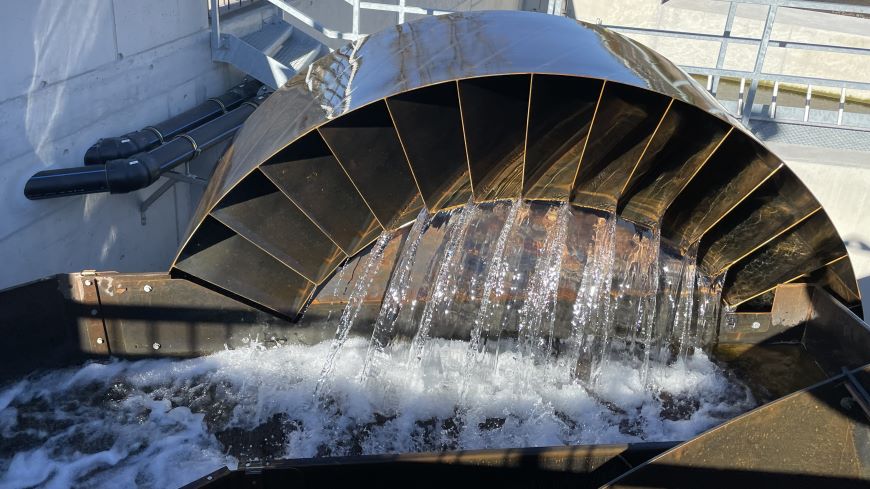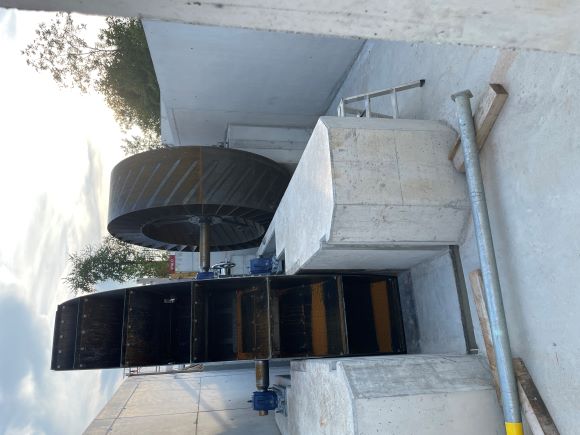Promoting biodiversity
Sustainable water wheel: old technology revisited
At the end of March, a new type of water pumping system was put into operation in Steffisburg. It ensures that a tributary of the Zulg river continues to be supplied with water despite improved flood protection. This is the second project of this kind in which Empa has been involved – a self-powered water wheel based on historical models.

In order to better protect Steffisburg in the canton of Bern from flooding, the Zulg river was lowered by around two meters at the “Müllerschwelle”. Nevertheless, the Mühlebach continues to be supplied with water: A new type of water scooping system pumps the water upwards and directs it into this tributary of the Zulg. Driven solely by hydropower, a water wheel over five meters in diameter rotates – and moves a scoop wheel via a cogwheel gearbox, which pours around 150 liters of water per second into a collecting channel. The historically inspired construction was officially inaugurated and put into operation on 29 March.
More hydropower needed

For centuries, the Mühlebach stream has shaped the townscape of Steffisburg – once as a source of energy for medieval businesses, later for small factories and today as part of a protected recreational area. The new water pumping system ensures that it continues to carry water. Originally, an electric screw pump was planned, but the engineers in charge were looking for a more sustainable solution. They found inspiration in Glattfelden in the Zurich lowlands: There, a water-pumping wheel based on a historical model supplies the river with water power and also serves as an eye-catcher in the local recreation area. A similar solution proved to be ideal for Steffisburg – sustainable thanks to renewable energy and also an attraction for the “Mühlebachweg” industrial nature trail with the historic “Saagi” and the “Fabriggli”.
Those responsible then contacted Silvain Michel from Empa's Mechanical Systems Engineering laboratory, who had already worked on the water wheel in the Zurich Unterland. According to the Empa engineer, the technical challenge was to adapt the water intake system to the requirements in Steffisburg. “With a minimum outflow of one cubic meter per second at the Zulg river, the wheel has to feed at least 125 liters of water into the Mühlebach. And even with lower inflows, at least 100 liters per second must still be pumped in order to maintain the biotopes.” On certain days, the show operation of the “Saagi am Mühlebach” even requires 150 liters per second.
Idea thanks to historical models

As traditional scoop wheels were not powerful enough for the conditions in Steffisburg, Silvain Michel developed a modern version of a historical concept: the Zuppinger wheel. This largely forgotten design by Swiss engineer Walter Zuppinger dates back to 1849. The so-called medium-shaft water wheel was specially optimized for low gradients. However, its high efficiency was only scientifically proven in 2016 in elaborate model tests at the TU Darmstadt and confirmed by the University of Stuttgart in 2018.
Experience from the Glattfelden project was also incorporated into the new concept. The key difference: a separate drive wheel that drives the scoop wheel via a gearbox. “This allows each wheel to run at its optimum speed – a prerequisite for the maximum efficiency of the system,” explains Michel, who determined the exact dimensions using calculation tools he developed himself. The EKZ design office in Thun was involved as a partner in the technical implementation. The final shape of the system was optimized using dynamic flow simulations at Empa and CFD-Schuck GmbH.
The commissioning proved that the concept works: In front of numerous guests, the system achieved the calculated output of up to 6.7 kilowatts. It was able to pump up to 209 liters of water per second – more than enough to operate the historic “Saagi”.
-
Share






